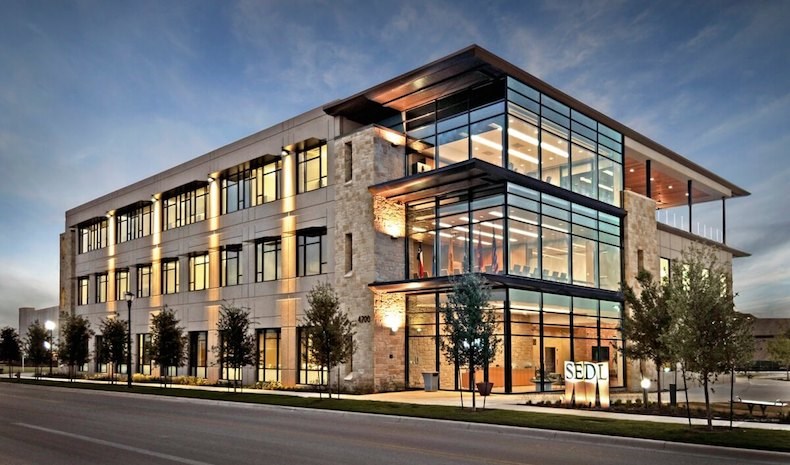A Step-by-Step Guide of the Design Process Followed by commercial architects
Discover the Cutting-edge Solutions Used by Commercial Architects for Your Next Job
Commercial architects play a vital duty fit the constructed environment. They mix performance with visual appeal, creating rooms that resonate with brand name identity. These experts use innovative style solutions, sustainable techniques, and progressed technologies to improve customer experiences. Their collaborative method assurances positioning with customer visions and operational needs. The extent of their solutions commonly expands past design. The following steps in understanding exactly how these architects browse complex job needs may shock you.
Comprehending the Role of Commercial Architects
Although the function of business architects might differ depending upon the details task, their key feature focuses on making functional and aesthetically appealing rooms for organizations. These professionals are tasked with understanding the unique demands of each customer, whether it be a retail shop, office complex, or commercial facility. They perform extensive site evaluations and team up with stakeholders to ensure that the design straightens with the service objectives and brand name identity.Commercial architects additionally browse various regulatory needs, protecting conformity with zoning regulations and building codes. Their competence reaches producing sustainable styles that advertise power effectiveness and ecological obligation. In addition, they handle the task's timeline and budget plan, collaborating with contractors and engineers throughout the building and construction procedure. By blending creativity with technological understanding, industrial architects play a necessary function in transforming conceptual ideas right into concrete facts, ultimately boosting the performance and charm of industrial areas.
Cutting-edge Layout Solutions for Special Rooms
As industrial rooms significantly require diversity to stand out in affordable markets, ingenious design options have ended up being vital for architects. These specialists take advantage of their imagination and technical proficiency to craft unique settings that show brand identification and improve customer experience. By integrating innovative modern technology and products, business architects can transform average rooms right into enchanting venues that engage customers and influence employees.Architects utilize various techniques, such as adaptive reuse, which revitalizes existing structures while protecting their historical importance. They likewise check out non-traditional designs and multifunctional spaces that cater to diverse needs, making sure versatility for future growth.Furthermore, the consolidation of biophilic design-- bringing nature indoors-- develops welcoming ambiences that promote wellness - commercial architects. This attention to detail in cutting-edge design not just addresses visual issues but also fosters community and cooperation. Eventually, these tailored solutions enable services to flourish in an ever-evolving landscape, setting them in addition to rivals
Lasting Design Practices
Sustainable style methods have actually become a critical emphasis for commercial architects seeking to produce impactful designs that reverberate with ecological stewardship. These practices prioritize the usage of renewable energies, power performance, and very little waste, showing a dedication to lowering the environmental footprint of structures. Architects incorporate materials that are sustainably sourced or reused, making certain that building methods align with eco-friendly principles.Furthermore, the combination of environment-friendly roofing systems and walls enhances biodiversity while boosting energy performance. Reliable water management systems, such as rainwater harvesting, add to sustainability by conserving water resources. All-natural air flow and daylighting techniques are additionally employed to optimize indoor settings, reducing reliance on man-made home heating and lighting.
Integrating Innovation in Architectural Designs
A boosting number of industrial architects are welcoming modern technology as a transformative aspect in architectural layout. By leveraging innovative software devices such as Structure Information Modeling (BIM), architects can produce detailed 3D representations of tasks, permitting boosted visualization and partnership amongst stakeholders. This modern technology facilitates real-time modifications, decreasing mistakes and simplifying the design process.Additionally, architects are integrating smart building modern technologies right into their designs, which improve power effectiveness and passenger comfort. Functions such as automated lighting, climate control, and safety systems can be flawlessly included, advertising sustainable practices and reducing operational costs.The usage of online and enhanced fact also permits customers to experience designs prior to construction begins, giving indispensable understandings into spatial relationships and aesthetic options. Ultimately, the assimilation of modern technology in architectural designs not just cultivates innovation but also assures that jobs are executed with precision and straightened with modern needs.

Task Management and Sychronisation Solutions
Efficient job management and sychronisation solutions are important for the effective execution of industrial architectural jobs. These services assure that all facets of a task, from preliminary style to last construction, are perfectly incorporated. Commercial redirected here architects play a significant duty in working with in between various stakeholders, consisting of clients, contractors, and suppliers, to maintain clear interaction and positioning on project goals.By applying organized methods, architects can take care of timelines, spending plans, and sources successfully, decreasing delays and expense overruns. They use task administration software program and devices to track progress, handle paperwork, and facilitate cooperation amongst team members.Additionally, these solutions include risk analysis and reduction methods, validating potential obstacles are identified and attended to proactively. The result is a streamlined procedure that enhances overall job effectiveness and high quality, inevitably resulting in a successful outcome that satisfies the client's vision and assumptions.
Regulative Conformity and Zoning Help
Effective regulative compliance and zoning aid are vital for the success of any industrial project. Architects must possess a deep understanding of regional guidelines and zoning laws to guide clients through the intricacies of the approval process. This experience not only ensures adherence to lawful needs but also helps maximize project style and performance.
Browsing Local Laws
How can industrial architects assure their styles straighten with neighborhood guidelines? By staying knowledgeable concerning the ever-evolving landscape of structure codes and neighborhood ordinances, architects play an important function in making certain conformity. They perform thorough research study to comprehend the specific laws regulating materials, safety standards, and building and construction methods appropriate per task. Working together closely with neighborhood authorities, industrial architects can navigate through the complexities of governing structures successfully. They also promote necessary authorizations and examinations, streamlining the approval procedure. This proactive technique not only reduces potential legal issues yet additionally improves project effectiveness. Inevitably, their experience in maneuvering regional regulations encourages clients to recognize their vision while adhering to all called for requirements and standards.
Zoning Legislation Proficiency
Zoning regulation know-how is essential for commercial architects guiding via the intricacies of land use policies. These architects have in-depth understanding of neighborhood zoning codes, which govern residential or commercial property growth, land usage, and structure requirements. By comprehending these policies, they aid customers navigate the often elaborate authorization procedures required for building projects. Their experience guarantees conformity with zoning legislations, reducing the risk of task hold-ups or lawful complications.Additionally, business architects give useful assistance in getting required authorizations and variations, facilitating smoother interactions with neighborhood authorities. They also use calculated recommendations to enhance site design and optimize the capacity of a home while adhering to zoning constraints. Eventually, their zoning law efficiency plays an essential role in the effective understanding of business projects.
Joint Approaches With Customers and Stakeholders
Effective industrial architecture rests on the capacity to foster solid collaboration with customers and stakeholders throughout the design process - commercial architects. Architects take part in open dialogues, ensuring that all events' visions and demands are integrated right into the task. This joint method Home Page starts in the preliminary phases, where architects conduct workshops and brainstorming sessions, enabling customers to express their goals and concerns.Stakeholder input is similarly vital; architects often organize meetings with area participants, local governments, and other relevant entities to collect varied perspectives. By using visualization tools, such as 3D modeling, architects facilitate much better understanding and communication.This iterative responses procedure not just enhances style top quality however also constructs depend on, causing more successful results. Ultimately, the collaborative viewpoint of commercial architects changes concepts into check functional rooms that mirror the aspirations of customers and the broader community, ensuring a harmonious relationship throughout the project lifecycle

Often Asked Concerns
What Is the Regular Timeline for a Business Style Project?
The common timeline for a commercial style job varies, usually spanning 6 to 18 months. Factors influencing this duration include project intricacy, regulative approvals, and customer responsiveness, impacting each phase from design to construction completion.
Just How Do Commercial Architects Fee for Their Providers?
Commercial architects typically charge based on job scope, intricacy, and dimension. Typical charge structures include per hour rates, repaired fees, or percentage-based costs computed from the overall construction price, making certain openness and alignment with customer expectations.
Can Commercial Architects Assist With Interior Style?
Commercial architects can certainly aid with interior layout, incorporating capability and visual appeals. Their know-how assurances natural areas that align with building vision, enhancing individual experience while satisfying regulatory requirements and customer purposes via innovative layout remedies.
What Types of Customers Do Commercial Architects Typically Function With?
Commercial architects commonly team up with diverse clients, consisting of businesses, federal government entities, educational institutions, and charitable organizations (commercial architects). Each client seeks tailored building options to meet specific useful and visual needs for their projects and settings
How Do Commercial Architects Stay Upgraded With Layout Patterns?
Commercial architects remain upgraded with layout patterns with constant education, attending industry meetings, participating in expert networks, and investigating emerging technologies. They also collaborate with various other experts to acquire insights right into ingenious materials and layout techniques.